A Friendly Football Match between Japan and Belgium (No.36)
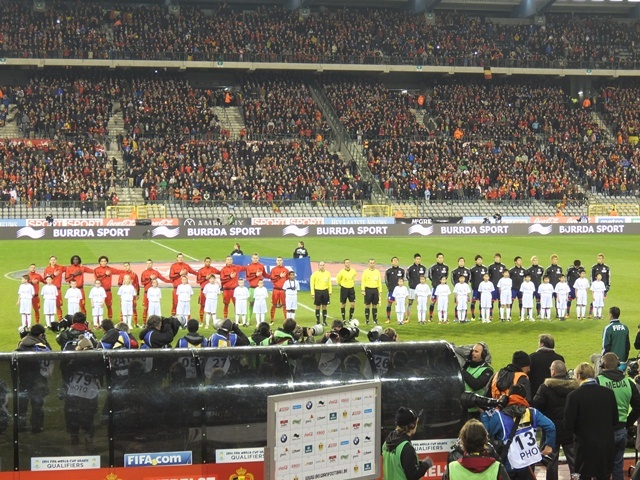
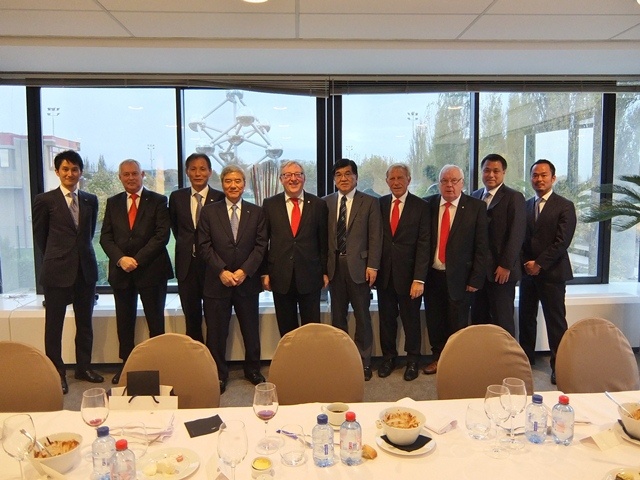 The day before yesterday, the Japanese and Belgian national football teams played a friendly match at the King Baudouin Stadium in Brussels. Both teams, already qualified for next year’s World Cup, played a good match as if it was for real. 3 days earlier, the Japanese team had secured a 2-2 draw against the Netherlands in Genk in the northeast of Belgium. By force of that momentum, they fought hard against the powerful Belgian team, 5th on the FIFA ranking, and won 3-2. I was lucky enough to be invited by the organizer, so I was able to watch the match from the VIP seats, but because the place was in a completely “away” environment, it was difficult for me to cheer overdoingly when Japan’s team had a chance to attack and I felt alone in an opposite circumstance. In fact, the national teams of Japan and Belgium have played 3 times against each other in the past with good results: one win and two draws for Japan. In particular, though a 2-2 draw at the World Cup 2002 co-hosted by Japan and South Korea, the Japanese team secured a 4-0 victory against the Belgian team at the Kirin Cup 2009, so Japan seems to have the edge on Belgium. On the day of the match, I had lunch together with the executives of both the Japanese and Belgian football associations. We engaged in a lively conversation about the old days and had an enjoyable lunch. The current coach of the Belgian team is Mr. Marc Wilmots who was captain of the Belgian team when they played against Japan in the World Cup 2002. The draw for the World Cup in Rio next year will take place on December 6th. Well, what groups will there be formed…? The day before yesterday, the Japanese and Belgian national football teams played a friendly match at the King Baudouin Stadium in Brussels. Both teams, already qualified for next year’s World Cup, played a good match as if it was for real. 3 days earlier, the Japanese team had secured a 2-2 draw against the Netherlands in Genk in the northeast of Belgium. By force of that momentum, they fought hard against the powerful Belgian team, 5th on the FIFA ranking, and won 3-2. I was lucky enough to be invited by the organizer, so I was able to watch the match from the VIP seats, but because the place was in a completely “away” environment, it was difficult for me to cheer overdoingly when Japan’s team had a chance to attack and I felt alone in an opposite circumstance. In fact, the national teams of Japan and Belgium have played 3 times against each other in the past with good results: one win and two draws for Japan. In particular, though a 2-2 draw at the World Cup 2002 co-hosted by Japan and South Korea, the Japanese team secured a 4-0 victory against the Belgian team at the Kirin Cup 2009, so Japan seems to have the edge on Belgium. On the day of the match, I had lunch together with the executives of both the Japanese and Belgian football associations. We engaged in a lively conversation about the old days and had an enjoyable lunch. The current coach of the Belgian team is Mr. Marc Wilmots who was captain of the Belgian team when they played against Japan in the World Cup 2002. The draw for the World Cup in Rio next year will take place on December 6th. Well, what groups will there be formed…?
<Wool Industry in Belgium Surviving in the 21st Century>
This month I paid a visit to Verviers, a city further to the east of Liège, close to the German border. Of the once flourishing wool industry in this city, now only two small and medium-sized companies are left. Belgium became a major centre of the wool industry from the 14th century to the 16th century in Europe and until the 19th century many factories spread out throughout the country. However, they rapidly declined by the second half of the 20th century and today they are on the verge of disappearing pushed aside by China and other Asian countries. And yet, although the two companies I visited have downsized substantially compared to before, I could see how they are determinedly surviving by transforming their business scope.
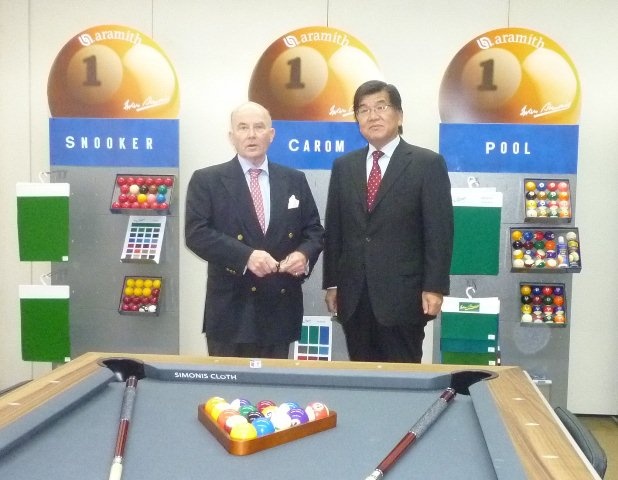 I first visited Ivan Simonis in Andrimont, a village in the mountains on the outskirts of Verviers. The company was founded in 1680 and used to be a leading company with about 2000 employees, engaged extensively in the textile industry, but because of the depression in the industry thereafter, it has turned into a small company of 70 employees now that produces only a felt cloth for covering billiard tables. However, the quality of the fabric of this company is said to be the best in the world and for most of the billiard tables at big international competitions this company’s products are used. The company has business partners in Chiba and Osaka in Japan and cooperated to support the victims at the time of the Great East Japan Earthquake. Also, I was a little surprised to hear that this company once became a sponsor of a Japanese billiard player. The variety of fabric colours, more than 25, was interesting. As was explained to me, dark green is usually used, but the blue-coloured fabrics look better on TV and are preferred for international tournaments. In the United States, billiard tables are often part of the home interior, which is why red, purple and other colours are also used for the fabric. No explanation is necessary for the choice of orange in the Netherlands… I first visited Ivan Simonis in Andrimont, a village in the mountains on the outskirts of Verviers. The company was founded in 1680 and used to be a leading company with about 2000 employees, engaged extensively in the textile industry, but because of the depression in the industry thereafter, it has turned into a small company of 70 employees now that produces only a felt cloth for covering billiard tables. However, the quality of the fabric of this company is said to be the best in the world and for most of the billiard tables at big international competitions this company’s products are used. The company has business partners in Chiba and Osaka in Japan and cooperated to support the victims at the time of the Great East Japan Earthquake. Also, I was a little surprised to hear that this company once became a sponsor of a Japanese billiard player. The variety of fabric colours, more than 25, was interesting. As was explained to me, dark green is usually used, but the blue-coloured fabrics look better on TV and are preferred for international tournaments. In the United States, billiard tables are often part of the home interior, which is why red, purple and other colours are also used for the fabric. No explanation is necessary for the choice of orange in the Netherlands…
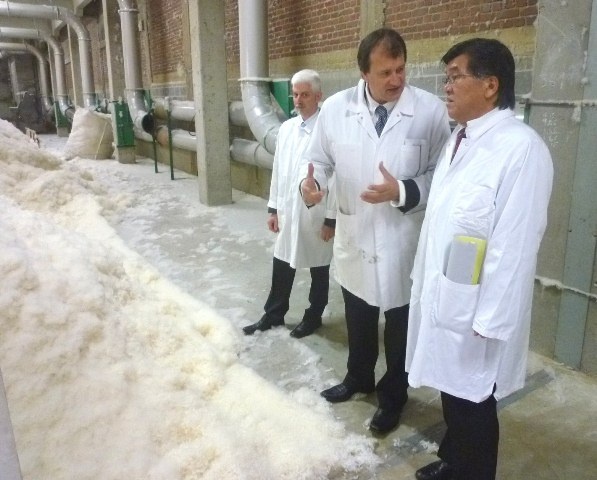 Another company is Traitex S.A., the only company in Europe active in the raw wool washing industry. The company that was founded in the late 19th century is specialized in the niche business of taking charge of the cleaning of raw sheep’s wool purchased by wholesalers from Europe, Australia, New Zealand and other countries. Sheared raw wool is not only dirty, but is also mixed with miscellaneous things such as pieces of straws and weeds and should be washed with a special technique before being processed into yarn. Traitex S.A uses a cleaning process of 240m. After washing off the dirt and bleaching the wool, the pieces of straws and weeds are carbonized so that they can be easily removed by using a fan-like machine to blow the powder off. Finally, the wool is dried. Its moisture ratio is reduced to less than 20% and it will be packed as a block as large as 1 cubic meter. This kind of washing technology is said to be the best in the world, so Traitex S.A. is receiving orders from all over the world and is offering the highest quality of raw material for wool products. Although a small company with 65 employees, a famous futon manufacturer in Osaka in Japan as well seems to buy the washed wool from this company (via a middleman). I was surprised to hear that this small Belgian company recently set up a subsidiary dealing with cashmere in Herāt in Afghanistan. A proud washing technology is alive there as well. Quite a resilient survival instinct, isn’t it? Another company is Traitex S.A., the only company in Europe active in the raw wool washing industry. The company that was founded in the late 19th century is specialized in the niche business of taking charge of the cleaning of raw sheep’s wool purchased by wholesalers from Europe, Australia, New Zealand and other countries. Sheared raw wool is not only dirty, but is also mixed with miscellaneous things such as pieces of straws and weeds and should be washed with a special technique before being processed into yarn. Traitex S.A uses a cleaning process of 240m. After washing off the dirt and bleaching the wool, the pieces of straws and weeds are carbonized so that they can be easily removed by using a fan-like machine to blow the powder off. Finally, the wool is dried. Its moisture ratio is reduced to less than 20% and it will be packed as a block as large as 1 cubic meter. This kind of washing technology is said to be the best in the world, so Traitex S.A. is receiving orders from all over the world and is offering the highest quality of raw material for wool products. Although a small company with 65 employees, a famous futon manufacturer in Osaka in Japan as well seems to buy the washed wool from this company (via a middleman). I was surprised to hear that this small Belgian company recently set up a subsidiary dealing with cashmere in Herāt in Afghanistan. A proud washing technology is alive there as well. Quite a resilient survival instinct, isn’t it?
<A French Lecture at the Catholic University of Leuven>
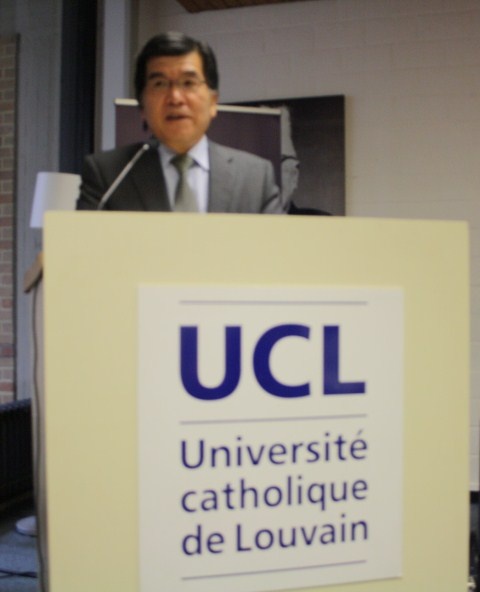
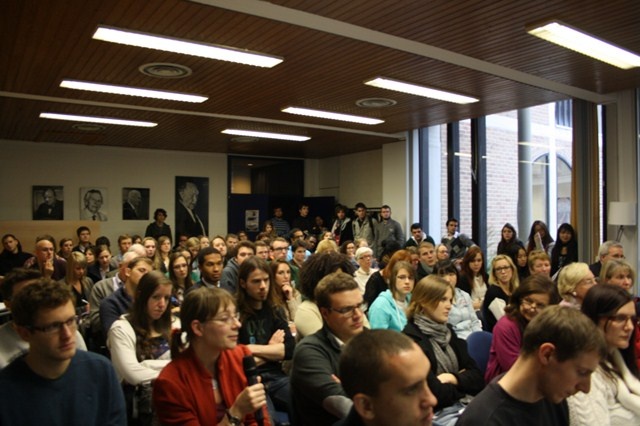 Last week, I paid a visit to the Université Catholique de Louvain (UCL), about 30 km southeast of Brussels and gave a one-hour lecture on “ The Past, Present and Future of Japan” in front of Rector Bruno Delvaux, other faculty members and about 100 students. I talked about Japan from the last days of the Tokugawa regime to the Meiji Restoration, then described the process of modernization and ended with my ideas on the formation of the Abe administration and the future challenges of Japan. The students seemed to be highly interested in my viewpoint that the Western countries were closely involved in the process of the creation of a strong centralized samurai state at the end of the 16th century and in the process of the collapse and disappearance of this samurai state with the Meiji Restoration of 1868. Especially, the viewpoint that the fact that the Portuguese who drifted ashore on Tanegashima Island in 1543 brought two guns to Japan completely changed the form of warfare and had a great influence on the rapid end of the rivalry of the local warlords of the Age of Warring States seemed very interesting to them. I did this lecture in French, but unlike English, you need to use your mouth and tongue more for the pronunciation. Not being used to speaking French every day, I was very tired after my one-hour lecture. I need a little more intensive training… Last week, I paid a visit to the Université Catholique de Louvain (UCL), about 30 km southeast of Brussels and gave a one-hour lecture on “ The Past, Present and Future of Japan” in front of Rector Bruno Delvaux, other faculty members and about 100 students. I talked about Japan from the last days of the Tokugawa regime to the Meiji Restoration, then described the process of modernization and ended with my ideas on the formation of the Abe administration and the future challenges of Japan. The students seemed to be highly interested in my viewpoint that the Western countries were closely involved in the process of the creation of a strong centralized samurai state at the end of the 16th century and in the process of the collapse and disappearance of this samurai state with the Meiji Restoration of 1868. Especially, the viewpoint that the fact that the Portuguese who drifted ashore on Tanegashima Island in 1543 brought two guns to Japan completely changed the form of warfare and had a great influence on the rapid end of the rivalry of the local warlords of the Age of Warring States seemed very interesting to them. I did this lecture in French, but unlike English, you need to use your mouth and tongue more for the pronunciation. Not being used to speaking French every day, I was very tired after my one-hour lecture. I need a little more intensive training…
<Ieper and the First World War>
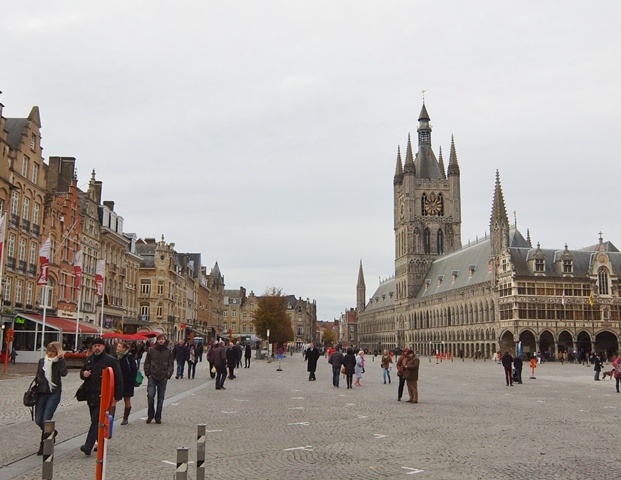
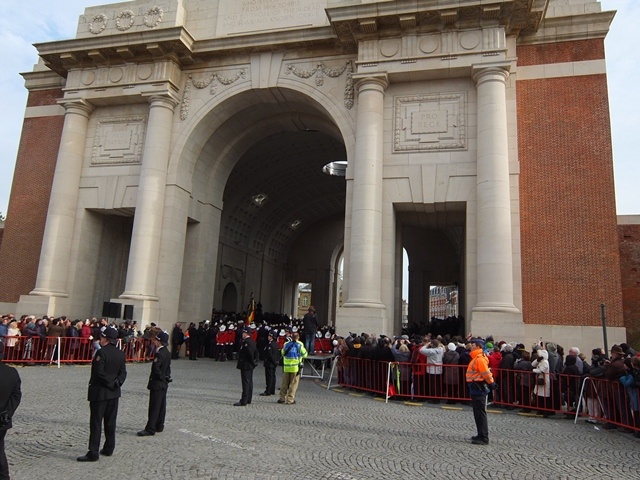 Last 11th, on Armistice Day, I visited the town of Ieper (120km to the west of Brussels) which is considered one of the hardest-fought battlefields of World War I. End 1914 the German army and British Commonwealth Forces are confronting each other on the outskirts of this town. A battle that would have continued for 4 years, taking alternately favourable and unfavourable turns. During that time poison gas was used, fighter planes were put into action resulting in a vast number of war dead. According to one report, the German army lost 250.000 men and the Commonwealth forces lost 300.000 men, a number that is a little hard to believe. There are many war cemeteries on the outskirts of the town covered with gravestones as far as the eye can see, engraved with the name and unit of the soldiers and showing diverse nationalities. That day a memorial service was held at the Menin Gate Memorial, which could be also called the east entrance of Ieper. The Gate being the important battlefield where the British army fought hard in defence and made great sacrifices, the British national anthem was performed and a bagpipe corps marched in. I think that there were many visitors from the United Kingdom, Australia, New Zealand and India among the participants to this ceremony and the people watching. Recently, I watched “The Battle of Passchendaele” (2008), a Canadian movie, on DVD and I could not help but shiver at the gruesomeness of the life-and-death battle (the so-called “Third Battle of Ieper”) deployed between the German army and the British and Canadian forces on the outskirts of Ieper in the autumn of 1917. I am also impressed that these memorial events continue to take place unbroken nearly 100 years after the war. Last 11th, on Armistice Day, I visited the town of Ieper (120km to the west of Brussels) which is considered one of the hardest-fought battlefields of World War I. End 1914 the German army and British Commonwealth Forces are confronting each other on the outskirts of this town. A battle that would have continued for 4 years, taking alternately favourable and unfavourable turns. During that time poison gas was used, fighter planes were put into action resulting in a vast number of war dead. According to one report, the German army lost 250.000 men and the Commonwealth forces lost 300.000 men, a number that is a little hard to believe. There are many war cemeteries on the outskirts of the town covered with gravestones as far as the eye can see, engraved with the name and unit of the soldiers and showing diverse nationalities. That day a memorial service was held at the Menin Gate Memorial, which could be also called the east entrance of Ieper. The Gate being the important battlefield where the British army fought hard in defence and made great sacrifices, the British national anthem was performed and a bagpipe corps marched in. I think that there were many visitors from the United Kingdom, Australia, New Zealand and India among the participants to this ceremony and the people watching. Recently, I watched “The Battle of Passchendaele” (2008), a Canadian movie, on DVD and I could not help but shiver at the gruesomeness of the life-and-death battle (the so-called “Third Battle of Ieper”) deployed between the German army and the British and Canadian forces on the outskirts of Ieper in the autumn of 1917. I am also impressed that these memorial events continue to take place unbroken nearly 100 years after the war.
<Leopold I and De Panne>
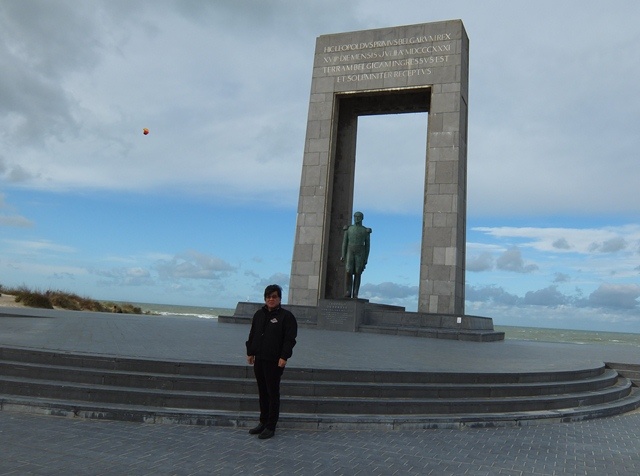 Just a few kilometres from the French border, on the westernmost tip of Belgium, there’s a small coastal town of about 10.000 inhabitants called De Panne. For the Belgians, the place is known as a good swimming beach in summer. Although more than 140km away from Brussels, De Panne can be reached in an hour and a half by car because of the highway running close to it. However, for history mania like me, De Panne is of interest because it was the place where the first king of Belgium, Leopold I, set foot on Belgian territory from Germany via Britain. On a weekend the other day, when I visited this area while enjoying the drive, my eye fell upon a statue of Leopold I, standing at a mere 100m from the shore, with his back turned to the Atlantic Ocean and facing towards Brussels. Having explained in detail about how a Prince from the House of Saxe-Coburg-Gotha became king of Belgium in “Ambassador’s Chat No. 27”, I will not repeat it, but it is very interesting to consider what the King (40 years old at the time) and Queen Marie-Louise, daughter of the French King, must have thought when they set foot on the beach of De Panne in midsummer. He was protestant and abandoned his dream of becoming the new king of Greece. For the first time in history a “country” was created, where he was “appointed” the first king of an overwhelmingly large number of Belgian Catholics. The dynamics of the European politics at the time brought forth a strange situation indeed. I think that the reason for choosing to disembark at De Panne, the closest point to France, also shows the agitation and anxiety of the new king… Just a few kilometres from the French border, on the westernmost tip of Belgium, there’s a small coastal town of about 10.000 inhabitants called De Panne. For the Belgians, the place is known as a good swimming beach in summer. Although more than 140km away from Brussels, De Panne can be reached in an hour and a half by car because of the highway running close to it. However, for history mania like me, De Panne is of interest because it was the place where the first king of Belgium, Leopold I, set foot on Belgian territory from Germany via Britain. On a weekend the other day, when I visited this area while enjoying the drive, my eye fell upon a statue of Leopold I, standing at a mere 100m from the shore, with his back turned to the Atlantic Ocean and facing towards Brussels. Having explained in detail about how a Prince from the House of Saxe-Coburg-Gotha became king of Belgium in “Ambassador’s Chat No. 27”, I will not repeat it, but it is very interesting to consider what the King (40 years old at the time) and Queen Marie-Louise, daughter of the French King, must have thought when they set foot on the beach of De Panne in midsummer. He was protestant and abandoned his dream of becoming the new king of Greece. For the first time in history a “country” was created, where he was “appointed” the first king of an overwhelmingly large number of Belgian Catholics. The dynamics of the European politics at the time brought forth a strange situation indeed. I think that the reason for choosing to disembark at De Panne, the closest point to France, also shows the agitation and anxiety of the new king…
|